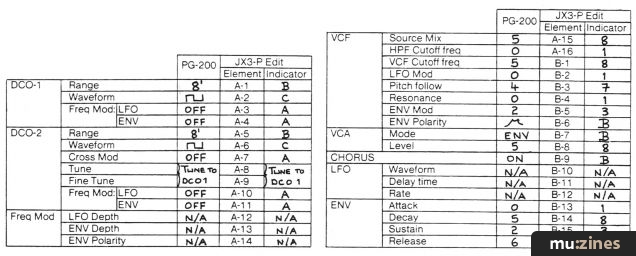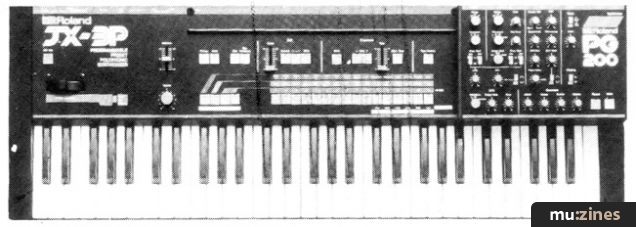Magazine Archive
Home -> Magazines -> Issues -> Articles in this issue -> View
Exploring New Territory | |
Gibson Explorer SynthArticle from Electronics & Music Maker, December 1985 | |
If you want Roland guitar synth sounds, you can now choose what guitar you use to play them. Paul White looks at a Gibson with a difference.
Up until now guitarists have had little choice as to what they use to control guitar synthesiser modules. But Gibson's new controllers are identical to the guitars that made them famous - except that they have Roland electronics built in.

This time last year, if you wanted a Roland guitar synth, you had to have a Roland guitar to play it from. That was fine so long as Roland's range of controllers (past and present) suited your style, technique, and all the rest of it. If it didn't, you had little alternative but to stick your head in a pig, as they say.
But now, several manufacturers including Gibson, Steinberger and Hamer, have collaborated with Roland to produce their own guitars with Roland interface electronics built in.
The electronics are needed because the Roland synth circuitry gets its pitch information by analysing the vibrations of each individual string to extract the fundamental frequency. To this end, the first thing you need is a separate pickup for each string, a function performed by a slimline hexa-pickup. This is located just forward of the bridge, so that any lateral string movement caused by bending won't move the string away from its designated pole-piece.
Once the vibrations have been picked up from the string, they are amplified by the guitar's electronics, and each string has its own sensitivity control so that the synth's response can be tailored to the player's technique and the type of strings fitted. Also incorporated in this electronics package is the circuitry for monitoring the guitar controls and the touch-sensitive vibrato plates fitted to the guitar.
Though these guitars are designed to interface with the Roland GR700 MIDI guitar synth (which synth players will recognise as having similar internals to theJX3P polysynth), they will work equally well with the previous GR300 floor unit. They aren't, however, capable of working with the old GR500, Roland's first and most ambitious foray into the world of guitar synthesis.
Roland's own G707 system guitar, distinctive because of its shape and damping arm, was designed to give clean, even string vibrations with the minimum of overtones, as these cause pitch tracking problems.
The model under review is a modified Gibson Explorer (they do a modified Les Paul, too), a guitar that's been in production for nearly 30 years and which, as a result, has a mechanical design that takes no account of any of these synth-related considerations.
Because the pickup output is buffered by the internal electronics, the control layout has to fall in line with the other Roland guitars; a standard electronics module fits all models. This means that apart from the standard 'one, other or both' pickup selector, there are only volume and tone controls which affect whichever pickups are selected. You still get a direct output from the pickups on a standard jack socket, though, for those occasions when you're not using the synth at all, or for when your setup incorporates a separate guitar amp.
But why use two amps in the first place? Why use separate sound systems for synth and guitar signals when a Balance control on the guitar gives you control over relative levels?
First off, all guitar amps incorporate a certain amount of top boost to give what we currently regard as an acceptable guitar sound. But a synth needs a setup with a fairly neutral response, and sounds better through a full-range speaker system that does nothing to flatter the electric guitar.
Then there's the fact that if the guitar and synth signals are mixed together, there's no way you can treat them separately. Not much use if you depend on effects processing for much of your guitar and/or synth sound...
But back to the guitar, and an as-yet-unexplained control marked Filter Cutoff. When the guitar is used with the GR700, this control is used for patch editing, as is the Filter Resonance control, a small black knob nearest the bridge. Last of all is the Vibrato Depth knob, which operates in conjunction with the vibrato parameters stored in the synth programs.
As the floor unit is identical to the one reviewed in E&MM June '84, I'll make but a brief resume of its functions. Like the JX3P, it can store up to 64 user programs, and it connects to the guitar by means of a locking multicore umbilical cord, which carries the low-voltage power, string signals and control information.
Although you can edit programs using just the GR700, life becomes much easier if you buy the optional PG200 programmer unit. This gives you lots of knobs to twiddle and switches to push, and obviates the need for that tedious increment/decrement business, a process that is to musical creativity what Vlad the Impaler was to embroidery.
So how well does the Gibson, a legend in its own lifetime but with not a hi-tech concession in its spec sheet, cope with being a synth controller?
Well, even the specially-designed Roland guitar needs to be carefully set up and played in a considerate manner to get it to behave. With that in mind, the Explorer does very well indeed. You need the right strings, and the distance between them and the hexa-pickup is crucial; set it up carefully according to the description in the handbook. That done, you have to develop an even, not too heavy-handed playing style if you don't want unscheduled accidentals appearing in your well-thought-out compositions. In particular, the open bottom E string has a tendency to yodel - though maybe a further go at setting up and a more even playing technique would take care of this, too.
The really good news is that the guitar itself doesn't seem to have suffered any after-effects as a result of its Roland implant. It still sounds like an Explorer, sure enough, even though the strings on the review model were starting to get a little dull, and I was too mean to replace them in case the expenses application was rejected.
By way of comparison, I tried my GR300 system guitar with the floor unit and found it tracked far worse than the modified Gibson. This is probably because the optimum setting of the guitar's sensitivity controls is different for the GR300 and the GR700 systems. And this is a pity, because you can buy a special splitter box that'll let you drive two floor units at the same time, and which could have been used for playing a 300 and a 700 at the same time.
The fact that top guitar manufacturers are producing Roland-compatible guitars must be an indication that guitar synthesis is at last being taken seriously. And why not? There's no reason why the synthesiser should be a keyboard-only instrument. OK, so pitch-following problems mean that the guitar is a singularly difficult device to use to drive a synth - which is why it's taken so long for guitar synths to reach high enough levels of technical competence.
But a keyboard isn't much good if you've spent the last 20 years practising heavy metal cliches. Guitar synthesis is one of the few avenues guitarists can take if they want to strike out in a new direction without abandoning everything they've learnt to date. And the more synth-compatible guitars there are available, the quicker the word will spread.
More from Rosetti Ltd, (Contact Details)
Also featuring gear in this article
Gibson Explorer Synth - Guitarcheck
(IM Feb 86)
Roland GR700 Guitar Synth
(12T Apr 84)
The Guitar Link
(ES Jun 84)
The Guitarist's Revenge
(EMM Jun 84)
The Six-String Synthesizer
(IM Feb 85)
Browse category: Guitar Synthesizer > Gibson
Browse category: Guitar Synthesizer > Roland
Featuring related gear
Polyphonic Synthesizers
(ES Dec 83)
Roland JX-3P and PG-200
(MU Sep 83)
Patchwork
(EMM Jun 84)
Patchwork
(EMM Aug 84)
Patchwork
(EMM Oct 84)
Patchwork
(EMM Dec 84)
Patchwork
(EMM Mar 85)
Patchwork
(MT Feb 89)
...and 5 more Patchwork articles... (Show these)
Browse category: Synthesizer > Roland
Publisher: Electronics & Music Maker - Music Maker Publications (UK), Future Publishing.
The current copyright owner/s of this content may differ from the originally published copyright notice.
More details on copyright ownership...
Gear in this article:
Review by Paul White
Help Support The Things You Love
mu:zines is the result of thousands of hours of effort, and will require many thousands more going forward to reach our goals of getting all this content online.
If you value this resource, you can support this project - it really helps!
Donations for April 2024
Issues donated this month: 0
New issues that have been donated or scanned for us this month.
Funds donated this month: £7.00
All donations and support are gratefully appreciated - thank you.
Magazines Needed - Can You Help?
Do you have any of these magazine issues?
If so, and you can donate, lend or scan them to help complete our archive, please get in touch via the Contribute page - thanks!



















